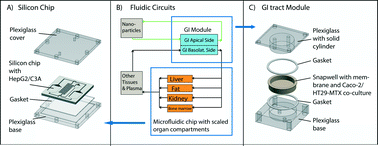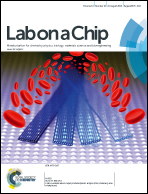Body-on-a-chip simulation with gastrointestinal tract and liver tissues suggests that ingested nanoparticles have the potential to cause liver injury
Abstract
The use of nanoparticles in medical applications is highly anticipated, and at the same time little is known about how these nanoparticles affect human tissues. Here we have simulated the oral uptake of 50 nm carboxylated polystyrene nanoparticles with a microscale body-on-a-chip system (also referred to as multi-tissue microphysiological system or micro Cell Culture Analog). Using the ‘GI tract–liver–other tissues’ system allowed us to observe compounding effects and detect liver tissue injury at lower nanoparticle concentrations than was expected from experiments with single tissues. To construct this system, we combined in vitro models of the human intestinal epithelium, represented by a co-culture of enterocytes (Caco-2) and mucin-producing cells (TH29-MTX), and the liver, represented by HepG2/C3A cells, within one microfluidic device. The device also contained chambers that together represented the liquid portions of all other organs of the human body. Measuring the transport of 50 nm carboxylated polystyrene nanoparticles across the Caco-2/HT29-MTX co-culture, we found that this multi-cell layer presents an effective barrier to 90.5 ± 2.9% of the nanoparticles. Further, our simulation suggests that a larger fraction of the 9.5 ± 2.9% nanoparticles that travelled across the Caco-2/HT29-MTX cell layer were not large nanoparticle aggregates, but primarily single nanoparticles and small aggregates. After crossing the GI tract epithelium, nanoparticles that were administered in high doses estimated in terms of possible daily human consumption (240 and 480 × 1011 nanoparticles mL−1) induced the release of aspartate aminotransferase (AST), an intracellular enzyme of the liver that indicates liver cell injury. Our results indicate that body-on-a-chip devices are highly relevant in vitro models for evaluating nanoparticle interactions with human tissues.

- This article is part of the themed collection: Organs on a Chip 2013

 Please wait while we load your content...
Please wait while we load your content...